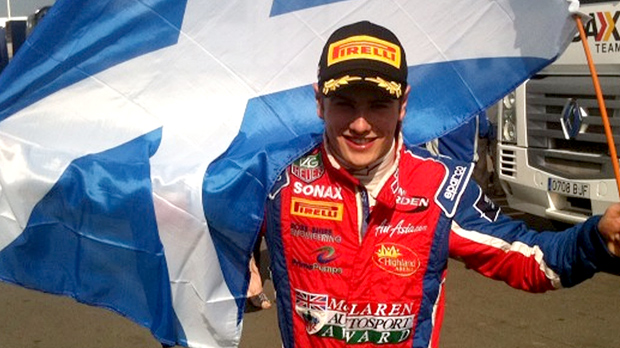Lewis Williamson wins GP3 final at Silverstone
Lewis Williamson wins his first GP3 victory at the British Grand Prix at Silverstone. Keme Nzerem meets the Formula 1 hopeful and finds out what it takes to cut it with the best.

The journey to Formula 1 from the feeder classes of GP 3 and formula Renault costs literally millions of pounds. And those that make it are few. The F1 grid this year only has space for 24 cars.
So who gets the big breaks? Scottish hopeful Lewis Williamson nearly gave up a few years ago. Even racing at a junior level sets you back tens of thousands a year.
But local businessmen decided to fund him, and he’s been paying them back with accolades ever since. This year he’s racing for Mark Webber’s GP3 team – and has been signed up for Red Bull’s talented driver programme. Today at Silverstone he won his first GP3 victory, leading all the way after passing three other drivers at the start of the race.
“Everyone’s end goal is F1”, Williamson says, “but you’ve got to remember that there’s only so many seats there”.
The Highland Arena driver from Golspie talks with the determination of someone who knows he’s on to a good thing, and thus he has to deliver.
That he’s sitting in the cockpit of Mark Webber’s F1 car while we talk (the one that won the British Grand Prix last year) is no bad thing for his confidence.
But confidence is one thing. Delivering the goods is another. He placed pole in the last GP3 in Valencia, and is racing at Silverstone on Sunday morning ahead of his F1 counterparts.
“There’s how many thousands who dream”, he accepts, and very few who make it. “But you’ve got to do best job going through these [lower] categories to maximise your chances”.
Williamson’s team – Arden – enjoy the odd pep talk from Mark Webber, and a simulator that loads all the Grand Prix circuits, plus weather conditions ranging from tropical to torrential.
GP3 cars are standardised to try and limit costs, but teams do what they can to gain legitimate advantages. It makes choosing the right driver all the more important – for both the track, and the bank balance. Arden’s chief engineer Jay Davenport has seen drivers come and go.
“You’ve got to have the skills”, says Davenport, but that’s just the start of it. “You need to be presentable to the media. You need to be a figurehead for a sponsor, somebody they want to invest money in”.
At this level, there is no free drive. “Generally drivers have to bring the money in themselves – through family money or sponsors”.
And don’t the families who introduce their children to karting – racing’s entry level – know it.
Starting with karting
For every driver that makes it all the way to the F1 grid, you can bet they would have started somewhere on a karting track.
British cadet champion Ronan McKenzie has just graduated to junior level. The 12 year old regularly beats drivers several years his senior
British cadet champion Ronan McKenzie has just graduated to junior level. The 12 year old regularly beats drivers several years his senior.
And the carrot dangling way, way off in the future? Eventually turning his hobby into a career – and racing at the very top level.
For his electrical engineer father Jason it’s “basically another full time job. It’s not like turning up on a Sunday morning to play footy”.
McKenzie Sr. and his fiancée raise sponsorship from local motor firms, and put in well over £10,000 a year of their own money to support Ronan as he races across the country and overseas. It’s a massive ask but he insists it’s fundamentally about having fun.
“We’re a great team”, he says. “Ronan tells me how he wants the kart set up, and I do it”. And his motivation? “when he comes in from a great race – beaming from ear to ear”.
-
Latest news
-
As India goes to the polls in the world’s largest election – what do British-Indians think?6m

-
Tees Valley: Meet the candidates in one of the biggest contests coming up in May’s local elections4m

-
Keir Starmer says public sector reform will be a struggle7m

-
Nicola Sturgeon’s husband Peter Murrell charged with embezzlement of funds from SNP1m

-
Ukraine might finally get $60billion in American weapons and assistance to defend against Russia3m

-




